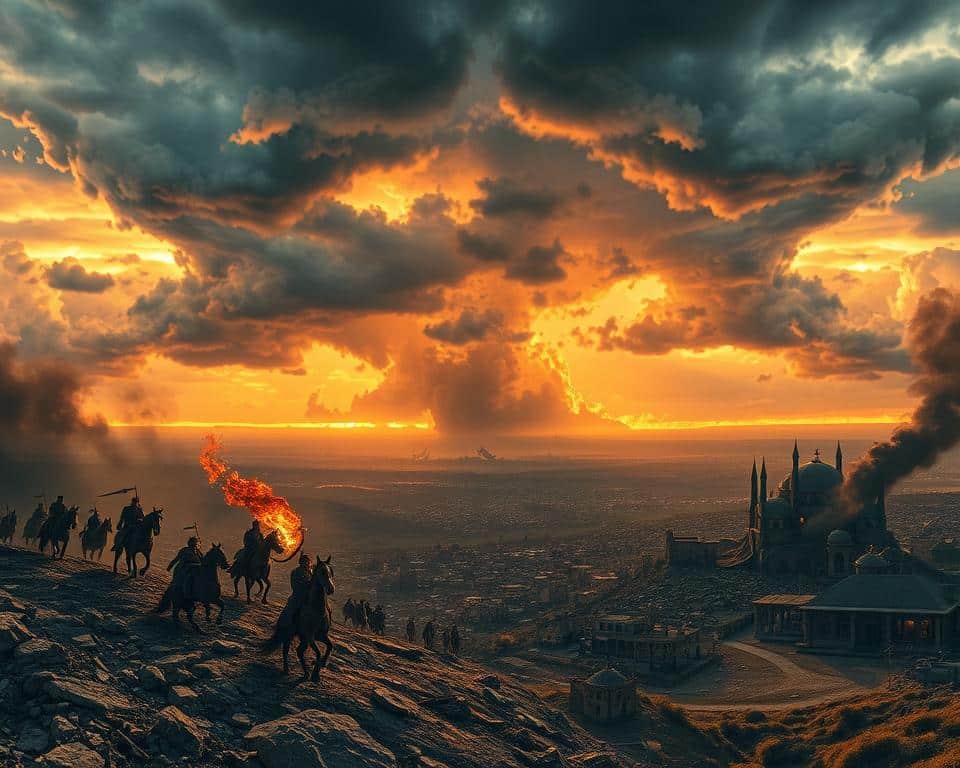Have you ever wondered what the Bible says about the future of our world? Scripture offers profound insights into God’s plan, revealing both warnings and hope for believers. In Daniel 12:4, the prophet foretold a time when knowledge would increase—a sign many connect to today’s rapidly changing events.
Though the world may seem uncertain, the Bible assures us that God remains in control. His promises provide clarity amid chaos. This article explores how ancient prophecies align with modern developments, offering a hopeful perspective rooted in faith.
What Are End Times Prophecies?

Biblical prophecies about the last days offer a roadmap for faith and understanding. These are God’s revealed plans for humanity’s culmination—a mix of divine justice and hope. From Daniel’s visions to Revelation’s promises, Scripture connects ancient kingdoms to Christ’s return.
Prophecies often focus on two themes: judgment for rebellion and redemption for believers. Daniel 9’s 70-weeks prophecy, for example, traces a timeline from Babylonian captivity to the Messiah’s reign. It’s not about fear but clarity—God’s way of preparing His people.
These events remind us to stay vigilant. Like a lighthouse guiding ships, prophecies point to God’s ultimate victory. They assure us that every crisis has purpose, and every promise will be fulfilled.
Key Biblical Books on End Times
Two ancient books hold the keys to understanding God’s plan for humanity’s future. Daniel and Revelation provide a divine framework, blending visions, symbols, and promises. Together, they reveal how God’s justice and redemption unfold across history.

The Book of Daniel
Daniel’s visions paint a sweeping portrait of world empires—from Babylon to Rome. His 70-weeks prophecy traces a timeline from Jewish exile to Christ’s crucifixion.
“He was given authority, glory, and sovereign power… His kingdom will never end” (Daniel 7:14).
These words aren’t just ancient history. They point to a future tribulation and God’s ultimate triumph. Daniel’s imagery—statues, beasts, and heavenly courts—sets the stage for Revelation.
The Book of Revelation
Revelation, the final book of the Bible, expands Daniel’s visions with vivid symbols. Seven seals, trumpets, and bowls depict earth’s final crises. Yet amid chaos, Christ’s victory shines: “The kingdoms of this world have become the kingdoms of our Lord” (Revelation 11:15).
Like puzzle pieces, Daniel and Revelation fit together. One starts with empires rising; the other ends with evil’s defeat. Both remind us: God’s plan is precise, and His promises are sure.
Daniel’s 70 Weeks Prophecy Explained
Daniel’s 70-week prophecy reveals a divine timeline that spans centuries. This coded message in Daniel 9:24–27 outlines God’s plan for Israel’s redemption and the future Messiah. You’ll discover how every detail—down to the year—points to Jesus and beyond.
The 70 Weeks Timeline
The “70 weeks” represent 490 years, divided into three segments. The first 69 weeks (483 years) began with Artaxerxes’ decree in 444 BC and ended at Christ’s triumphal entry in 30 AD. This precise fulfillment confirms Scripture’s reliability.
Yet the final “week” (7 years) remains unfulfilled—a gap scholars link to the church age. This pause hints at a future tribulation period before God’s kingdom is fully established.
Messianic Kingdom Characteristics
Daniel 9:24 lists six traits of the Messiah’s reign:
- Ending rebellion against God
- Establishing eternal righteousness
- Fulfilling vision and prophecy
“To seal up vision and prophecy, and to anoint the Most Holy” (Daniel 9:24).
These promises culminate in Christ’s return. Israel’s 1948 restoration mirrors prophecy, signaling we’re nearing the end age. God’s timeline is perfect—every event unfolds as He ordained.
Nebuchadnezzar’s Dream and End Times
King Nebuchadnezzar’s dream in Daniel 2 unveils a divine blueprint for world history. This vision—a towering statue of metals and clay—foretells the rise and fall of earth’s final empires. More than ancient prophecy, it reveals clear signs of God’s plan unfolding today.
Interpretation of the Multi-Metallic Man
Daniel decoded the statue’s layers as four kingdoms:
- Gold head: Babylon’s dominance (Daniel 2:38)
- Silver chest: Medo-Persia’s rule
- Bronze belly: Greece’s conquests
- Iron legs: Rome’s enduring power
The iron-clay feet symbolize a fragile alliance ofnationsin the last days—strong yet brittle, like today’s unstable governments.
Symbolism of the Mountain
A stone “cut without hands” strikes the statue, bringing sudden destruction (Daniel 2:34). This mountain represents Christ’s eternal kingdom—uniting nations under His righteous rule. Human power crumbles, but God’s reign stands forever.
“The God of heaven will set up a kingdom that will never be destroyed” (Daniel 2:44).
Ten toes on the statue hint at Revelation’s ten-king coalition, but the mountain’s victory is certain. Every empire falls; only God’s truth remains.
The Role of the Antichrist
The Bible warns of a powerful leader who opposes God’s truth. This figure, called the Antichrist, will emerge during a time of global unrest. His rise marks a pivotal moment in God’s plan—a test of faith for all people.
Identifying the Antichrist
Scripture reveals key traits of this deceptive ruler:
- He rises from a revived Roman Empire territory (Daniel 7:8).
- He confirms a 7-year peace treaty with Israel, then breaks it (Daniel 9:27).
- He demands worship as God, mimicking Christ’s authority (2 Thessalonians 2:4).
Though many speculate, Jesus cautioned against premature identification:
“For false messiahs will appear and perform great signs” (Matthew 24:24).
Focus on theevents, not the individual.
The Abomination of Desolation
At the tribulation’s midpoint, the Antichrist will desecrate Jerusalem’s temple. Jesus called this the “abomination of desolation” (Matthew 24:15)—a blatant defiance of God. This act triggers unprecedented persecution.
Revelation 13 ties this to the “beast’s image,” a symbol of forced allegiance. Yet God’s power prevails. His victory is certain, even in darkness.
The Great Tribulation
Scripture describes a future time of intense testing called the Great Tribulation. This 3.5-year period will bring unprecedented challenges, yet God’s faithfulness remains unwavering. Daniel and Revelation outline its events—not to frighten believers, but to prepare them.
Duration and Events
The Tribulation spans 42 months (Revelation 11:2), marked by:
- Martyrdom of believers who refuse the mark of the beast
- Natural disasters signaling God’s judgment
- Global enforcement of the beast’s economic system
Despite chaos, Revelation’s 144,000 sealed witnesses proclaim truth. Their divine protection confirms: God never abandons His people.
Survival and Hope
How can you stand firm? Scripture offers practical guidance:
- Memorize God’s promises (Psalm 119:11)
- Stay faithful amid persecution (Matthew 24:13)
- Trust in Christ’s imminent return
“He who endures to the end will be saved” (Matthew 10:22).
The Tribulation’s darkest days culminate in Christ’s victory. This is our hope—evil’s defeat and eternity with Him.
The Second Coming of Jesus
The Bible’s most anticipated event is Christ’s return to establish His kingdom. Unlike hidden rapture theories, Scripture describes a visible, triumphant arrival that transforms heaven and earth. This moment fulfills God’s promise to redeem His people and judge evil forever.
Signs of His Return
Jesus Himself outlined cosmic disruptions signaling His second coming: “The sun will be darkened, and the moon will turn blood-red” (Matthew 24:29). These aren’t metaphors—they’re literal upheavals shaking every nation.
His return will be undeniable. Revelation 1:7 says “every eye will see Him,” ending speculation. Angels will gather believers, while the Antichrist’s armies face divine justice. This is our hope—evil’s final defeat.
Establishing the Millennial Kingdom
Christ’s 1,000-year reign begins with Satan’s binding (Revelation 20:2). Nations are judged, and the curse on creation lifts. Isaiah 11:6–9 depicts wolves dwelling with lambs—a restored earth under His rule.
The millennial temple will operate differently. Ezekiel 40–48 details worship without sacrifices, pointing to Jesus’ finished work. Daniel’s prophecy of “everlasting righteousness” (Daniel 9:24) becomes reality.
“The Lord will be king over the whole earth” (Zechariah 14:9).
This isn’t folklore—it’s God’s unshakable plan. Every prophecy about Christ’s second coming assures us: His victory is certain.
Matthew 24:14 and Global Missions
Jesus gave a clear mission to His followers—one that shapes history’s final chapter. In Matthew 24:14, He said, “This gospel of the kingdom will be preached in all the world as a witness to all nations, and then the end will come.” This isn’t just a suggestion; it’s a divine deadline tied to God’s timeline.
The Gospel Preached to All Nations
When Jesus said “nations,” He meant ethnic groups, not political borders. Today, over 5,000 people groups still lack access to Scripture in their heart language. Yet progress is undeniable. The Bible is now translated into 3,500+ languages—a leap from just 200 years ago.
Modern tools like digital Bible apps and satellite radio accelerate this work. But gaps remain, especially in Muslim, Hindu, and Buddhist regions. These areas need disciples willing to share God’s truth in culturally relevant ways.
Current Progress in World Evangelism
Missionaries today use innovative strategies:
- Bible translation projects for oral cultures
- Underground church planting in restricted nations
- Media outreach through local radio and social platforms
“How beautiful are the feet of those who preach the gospel of peace!” (Romans 10:15).
You don’t need to move overseas to help. Supporting translators, praying for unreached groups, or funding audio Bibles all advance the mission. Every effort brings us closer to the day when “every nation” hears—and Christ returns.
Common Misconceptions About End Times
Many people get caught up in myths when studying biblical predictions. These errors can distort our understanding of God’s plan and create unnecessary fear. Let’s clear up two major misunderstandings that confuse believers today.
Predicting the Exact Date
History is littered with failed date-setting attempts—from 1975 to 2011. Jesus settled this debate: “No one knows about that day or hour” (Matthew 24:36). Date predictions ignore God’s wisdom in keeping the time hidden.
Healthy watchfulness means living ready, not obsessing over calendars. Prophecy isn’t about calculating dates but cultivating faithfulness. Every generation should live as if Christ could return today.
Focusing Only on Doomsday
Some fixate on disasters while missing redemption’s hope. Yes, Revelation describes signs like wars and earthquakes—but these birth pains lead to Christ’s victory. The end time isn’t just about judgment; it’s God restoring all things.
Balance prophecy study with active discipleship. Feed the hungry. Share your faith. As we wait, our mission continues.
“Occupy till I come” (Luke 19:13).
Signs of the End Times Today
Global shifts align with God’s prophetic timeline like never before. From Israel’s rebirth to digital revolutions, Scripture’s ancient warnings feel strikingly relevant. These signs aren’t coincidences—they’re divine markers urging us to stay alert.
Current Events and Prophecy
Israel’s 1948 restoration mirrors Ezekiel’s “dry bones” vision (Ezekiel 37:11–14). After 2,000 years, a nation reborn in a day—just as God promised. Today, tensions over Jerusalem’s Temple Mount hint at future fulfillment.
The European Union’s unified economy echoes Daniel’s “revived Roman Empire” (Daniel 2:41–43). Ten core nations could foreshadow Revelation’s ten-king coalition. Meanwhile, rising persecution matches Jesus’ warning: “You will be hated by all nations” (Matthew 24:9).
Israel’s Role in Prophecy
God’s covenant with Israel remains central. Control of Jerusalem in 1967 and modern aliyah (Jewish return) confirm Scripture’s accuracy. Zechariah 12:3 predicts global conflict over Jerusalem—a reality in today’s headlines.
Technology’s explosion fulfills Daniel 12:4: “Knowledge will increase.” Social media spreads the gospel faster, yet also fuels deception. These events suggest we’re the generation that will see Christ’s return.
“When you see these things happening, know that the kingdom of God is near” (Luke 21:31).
God’s timeline is precise. Every sign points to His faithfulness—and our call to share His hope.
How to Live in Light of End Times
Living with eternity in mind changes how we see today. God’s promises about the future aren’t just for tomorrow—they’re guidance for how we walk right now. Scripture gives us clear steps to stay faithful while we wait.
Spiritual Preparedness
1 Thessalonians 5:6-8 urges believers to stay alert and sober. This isn’t about fear but focus. Like a runner training for a race, we prepare by:
- Reading God’s Word daily for discernment
- Praying for wisdom to navigate challenges
- Staying connected to a faith community
Jesus’ parable of the faithful servants (Matthew 24:45-51) reminds us: readiness isn’t passive. It’s actively serving where God places us.
Continuing God’s Work
The best way to combat anxiety about the future is to invest in what lasts. Share hope with neighbors. Support missions. Live generously. As Paul wrote:
“Let us put on the armor of faith and love, and the hope of salvation as our helmet” (1 Thessalonians 5:8).
Balance watchfulness with daily responsibilities. Work honestly. Love your family. God’s timeline doesn’t excuse neglect—it motivates faithfulness. This is the life of true understanding.
Hope in End Times Prophecies
Amid life’s uncertainties, God’s promises shine brightest. Scripture doesn’t just predict chaos—it reveals a future where every tear is wiped away. This is the heart of biblical hope: not escapism, but confidence in Christ’s victory.
God’s Ultimate Plan
Revelation 21:4 paints a breathtaking picture: “He will wipe every tear from their eyes.” No more pain. No more death. This isn’t a metaphor—it’s God’s guarantee. The New Jerusalem descends, bringing eternal peace to a broken world.
Earth’s trials fade in light of this promise. While kingdoms rise and fall, God’s kingdom stands unshaken. His plan isn’t reactionary; it’s intentional. Every prophecy points to restoration, not destruction.
Assurance for Believers
Romans 8:38-39 offers unshakable assurance: Nothing can separate us from God’s love. Not tribulation. Not persecution. This hope anchors us today, no matter the headlines.
Christ’s resurrection is the proof. Death couldn’t hold Him—and it won’t hold His followers. God’s word assures a resurrection where believers receive glorified bodies, free from sin’s curse.
“The sufferings of this present time are not worthy to be compared with the glory which shall be revealed” (Romans 8:18).
Live with this confidence. Share this hope. In a world searching for answers, you carry the ultimate truth: God wins, and His people share in His triumph.
Final Thoughts on End Times Prophecies
Biblical hope transforms how we face tomorrow. God’s Word has proven reliable through fulfilled predictions—from Israel’s rebirth to Christ’s resurrection. This hope isn’t wishful thinking; it’s rooted in divine truth.
Live with urgency, not panic. As Roger Barrier wisely said, “Plan as though 1,000 years remain; live like He comes in 10 minutes.” Stay faithful in sharing the gospel—our Great Commission mandate.
God’s faithfulness spans generations. His promises for the future anchor us in today’s chaos. Whether through service, prayer, or study, deepen your understanding of His plan.
Trust Christ as your secure foundation. In a world of uncertainty, His victory is certain. Let Scripture’s light guide your steps until He returns.





